Knitted Charming Pocketed Purse Bag
Introducing the Enchanting Pocketed Purse Bag, a delightful accessory that combines the artistry of knitting with the practicality of a purse. This unique bag is handcrafted with love, using the finest quality yarns to create a charming and eye-catching design. The intricate knitting pattern adds a touch of elegance, making it a perfect accessory for any occasion. Whether you need to carry your phone, keys, wallet, or makeup, this bag has got you covered. The pockets are thoughtfully designed to keep your belongings organized and easily accessible. The soft and durable knitted fabric ensures that your items are well-protected while adding a touch of warmth and comfort to your ensemble. Step out in style with the Enchanting Pocketed Purse Bag and let its charm and practicality enhance your everyday look.

Skill Level- Beginner/Intermediate
Materials- 300 yds bulky weight yarn, or 3 balls Knit Picks Brava Bulky yarn (shown in picture). Note: While you don’t have to line the bag, I recommend at least sewing a ribbon or fabric strip inside the handles to keep them from stretching out.
Gauge- 3.5 stitches per inch in stockinette on size 9-11 circular needles
Finished Size: 10 inches tall by 13 inches wide
Directions:
Using the Magic Cast On, CO 84 sts (42 sts per needle). Knit one round even. Note: The cast-on loops on needle #2 are twisted. On the first round only, knit them through the back of the loops to untwist them. After this round, the stitches will all be worked normally.
Set Up Round: On first needle, kf&b, pm, k40 in Chart A, pm, kf&b. Repeat across second needle. Note: When working across second needle, it may be easier to perform the kf&b if you untwist the stitch first.
Increase Round: On first needle, knit to one stitch before marker, kf&b, sm, k40 in pattern, sm, kf&b, k to end of needle. Repeat across second needle.
Repeat increase round 5 more times. 112 sts (56 per needle)
Even Round: k to marker, sm, k40 in pattern, sm, k to end of needle. Repeat across second needle.
Repeat an increase round followed by an even round one more times. 116 sts (58 per needle)
Repeat even round until desired height of pocket is reached, ending having knitted row 4 on Chart A (a cable cross row.)
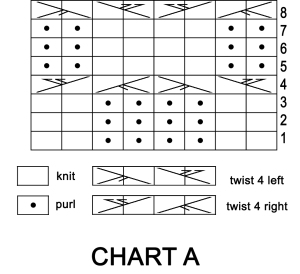

CO 24 sts on new needle. Knit in stockinette stitch for 18 rows or desired length, ending having worked a WS row.
Increase Row (RS): k1, m1, [k2, m1] 11 times, k1 (36 sts)
Set Up Row (WS): p2, k2, [p4, k4] 3 times, p4, k2, p2
Work sts as they appear for two more rows. (knit the knit sts, and purl the purl sts)
Cross Row (RS): k2, work row 8 of Chart A till 2 sts remain, k2
INSERT POCKET
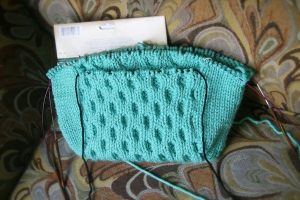
Set Up: On first needle of bag, k across to marker, sm, p2, slip next 36 sts to waste yarn
Work Pocket Sts: Pick up pocket and begin using pocket stitches in place of the sts moved to waste yarn. [k4, p4] four times, k4.
Work Rest of Front Sts: Resume working with remaining body sts. P2, sm, k until end of needle.
On second needle of back, k across to marker, sm, work next 40 sts in pattern (row five of Chart A), sm, k to end of needle.
Even Round: On first needle, k across to marker, sm, work next 40 sts in pattern (starting on row six of Chart A), sm, k to end of needle. Repeat for second needle.
Repeat Even Round until bag reaches desired height, ending with having completed either row 4 or row 8 of Chart A.
PLEATS AND REDUCE
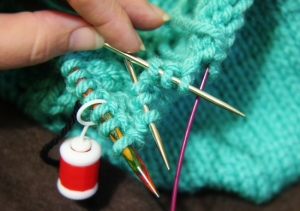
Reduce: On first needle, k across to marker, sm, [k2tog, k1, k2tog, k1, k2tog] five times, sm
First Pleat: Move next 3 sts to DPN, move the next 3 sts to another DPN. 3 sts remain on left needle. Fold these 3 sets of 3 sts like an accordian to resemble a Z with left needle held in the back. [Knit the first st of all 3 needles together] repeat two more times.
Second Pleat: On second needle, move 3 sts to DPN, move next 3 sts to another DPN. Fold these 2 DPNs behind the left needle like an accordion to resemble a Z with left needle in the front. [Knit the first st of all 3 needles together] repeat two more times.
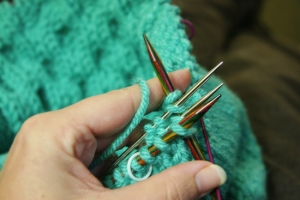
Reduce: Continuing on second needle, sm, [k2tog, k1, k2tog, k1, k2tog] five times, sm.
Third Pleat: Continuing on second needle, move next 3 sts to DPN, move the next 3 sts to another DPN. 3 sts remain on left needle. Fold these 3 sets of 3 sts like an accordian to resemble a Z with left needle held in the back. [Knit the first st of all 3 needles together] repeat two more times.
Fourth Pleat: On first needle, move 3 sts to DPN, move next 3 sts to another DPN. Fold these 2 DPNs behind the left needle like an accordion to resemble a Z with left needle in the front. [Knit the first st of all 3 needles together] repeat two more times. 74 sts (37 per needle)
Begin Ribbing: Continuing on first needle, [k1,p1] repeat until end of needle. On second needle, [k1, p1] across needle.
Even Ribbing: On first needle, [p1, k1] across. On second needle, [k1, p1] across.
Work Even Ribbing round 3 more times. Bind off with preferred method.
FINISHING POCKET
Move all pocket sts from waste yarn to circular needle. 36 sts.
Reduce: On RS with new yarn, k2, [k2tog, k1, k2tog] 6 times, k2tog, k2. 23 sts.
Rib: On WS, [p1, k1] 11 times, p1
Work sts as they appear 4 more rows. (knit the knit sts, purl the purl sts.)
Bind off using preferred method.
Sew sides of pocket ribbing to purse using invisible stitches.
Sew down the inside of pocket to inside of bag.
HANDLES
Make two. CO 5 sts, work in garter stitch until handles are 23 inches long or preferred length. You can slip the first st of every row if you desire. Bind off using preferred method.
Sew one handle to the inside of bag at each side of front. Sew the other handle to the inside of back at each side of back.
If you want to line the bag and handles, make linings, attach to purse and handles, then attach handles last.
LINING
To make the lining of the handles:

Measure the width and length of each handle and cut a strip of fabric to the exact size. Turn the edges under 1/4 inch and sew them right next to the edge. Ironing them under first helps a lot. Lay the handles out straight on a table and place the fabric strips on top of each one. Pin the fabric to the handles being careful to not stretch the knitted handles (or the fabric won’t fit). I then used tiny invisible back stitches to sew the fabric down, making sure I caught some yarn with each stitch.
To make lining of the bag:
Flatten the bag. Measure from the top of the bag to the bottom. Measure the width of the honey comb panel from side to side. Cut a piece of fabric twice the height and once the width plus whatever material will be in the seam (I added 5/8 inch to each side, the standard seam measurement.) You do not need to add for a seam for the height because it will curve up in the bag like a U with no seam.
If you want pockets, now is the time to cut them and add them. Cut a rectangle of fabric the size of the pocket plus seams, turn the edges under and sew them next to the edge to keep the edges under. Place pocket where desired on lining and sew in place.
The Sides: Measure the width of the side of the bag at it’s fullest point. Cut 2 rectangles that are the height of the flattened bag and the width of the bag at it’s fullest point plus seams (5/8 inch for each side for me).
Now for the tricky part: You will need to make a curve shape at the bottom of each side rectangle that matches the curve of the bag, keeping in mind that you will also need to add 5/8 inch around for the seam. I took the bag and laid it on it’s side on top of the fabric and drew around the curve.
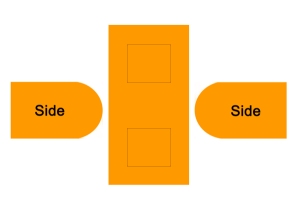
Assembly: You will need to attach each curved side to the long rectangle middle, with right sides together. The long rectangle middle piece will U around the curve of each side. I started in the middle of the long side of the large rectangle and the middle of the curve of a side piece and pinned it around to the top and then sewed it under the machine. I then pinned the other side of the curve starting in the middle and worked my way up. Ditto for the other curved side piece.
The pleat: Now, you need to reduce the top of the lining to match the pleat on each side. I accordion-folded the sides of the lining to mirror the pleats on the side of the bag and sewed them 1/2 inches from the top edge of the lining and then again 1 1/2 inches from the top edge of the lining
Closures: Now’s the time to add any magnetic closures you might want to add.
Insert the lining into the bag and fold over the top of the lining to the wrong side to the height that you desire. Pin it or mark it somehow and take it to the iron and iron it down to make it neat and/or sew the top of the lining down. Insert it back into the bag and hand stitch it to the bag. I used tiny invisible back stitches making sure that I caught some yarn with every stitch.
If you want to line the front pocket, measure the height and width of the pocket interior. Cut a rectangle double the height and one width plus seams (5/8 inch per side for me). Fold the rectangle in half height-wise with right sides together and stitch both sides. Fold over top edge 1/4 inch and then again 1/4 inch and sew it down. Add any magnetic closures, if you like. Insert into pocket and stitch into place.
Attach handles to back at inside edges.
You can get crazy with this and add iron-on interfacing to the lining to give the bag more structure. I used an iron-on thin batting from my local quilting store. I ironed it on to the pieces before assembly. If you use magnetic closures, you will want to add a little more heft in there to support the closures, like a small piece of interfacing. You can add inside pockets or not. Your imagination is the limit.